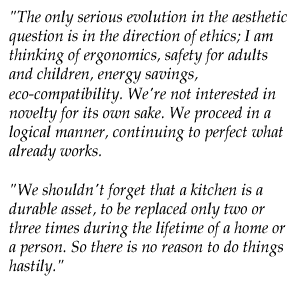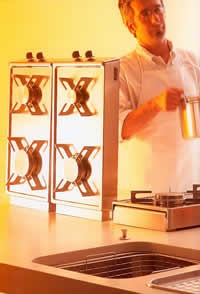 |
We are what we eat -- and how and where and when we eat it. Nutrition patterns mold our personalities and our cultural identity, producing both stereotypes and archetypes. Ghandi could only have been skinny; Buddha could only have been fat. Food and nutrition contain archaic, deeply rooted systems of symbols in all cultures: from the Easter egg to the unleavened bread of the Jews to the tea ceremony of the Japanese. And apart from the substance of food, wise men say, the most important thing is how and where it is prepared and consumed, in whose company, how many times as day; in short, the entire complex of ritual behavior that surrounds the act of eating. As we know, rituals have a way of evolving, disappearing, developing, changing name and form -- but they can not be replaced.
Over the last 50 years, the rituals of food and eating have changed radically. First of all, the influence of religion has has waned, and with it the tradition of food for weekdays, feastdays, special sweets for births and deaths, fish on Fridays, special foods for Lent or Christmas. Demographic mobility, immigration, and telecommunications have challenged local and regional identity. Taking Italy as an example, "Mediterranean" dishes, rebounding from their trip to the States, have spread to regions of Italy that are not Mediterranean at all, just as the rice dishes and smoked meats of the Tyrol can now be found even in the remotest corners of the South. At the same time, industrial civilization and the era of "real-time" have erased the sense of the seasons, the flavors of autumn fruits, the correct "ripening" of cheeses, cured meats, wines, the mention of early produce. Even during the course of the day our habits have changed: our lunches are rapid, frugal, nearly always consumed outside of the home, while dinners have become slower, more abundant in compensation. If we add to this basic scenario, the factors of the "Americanization" of customs, the global market, youth rhetoric, the pseudoscientific information avalanche on vitamins, calories, cholesterol, saturated, unsaturated, hydrogenated fats, the explosion of the "natural," we can immediately realize that the game is up, it seems there is no turning back in the face of so many different trends.
 But
within this fluid panorama certain things are crystalizing, things that deal
with our real, everyday lives, defining the sensibilities of an increasingly
aware consumer who can afford to consciously choose his or her approach to
the preparation and consumption of food. The first indication, common to a
variety of sectors, is the economic and cultural paradox of "the more
global, the more local" -- in other words, the larger the scale of phenomena,
the more local identity will be emphasized, if only in reaction. Thus we can
observe that, for over a decade now, the phenomenon of the "Slow Food"
movement, with which champions of the savoir vivre respond to the decline
of taste caused by the spread of fast food outlets. Slow Food focusses on
a reassessment of regional and local cuisine, the rediscovery of "typical"
products, "humble" foods, slow preparation, diversified tastes.
Moreover, recently, the movement's attention has turned to the utensils and
objects of the past for the conservation, preparation, and cooking of foods.
The objects are being produced once again, using traditional techniques, as
in the case of the "Chitarra" used to make spaghetti in Abruzzo,
or they are redesigned using modern technologies, while preserving their original
functions. Polenta, for example, may still be served on a cutting board, but
the board will be lighter and more practical than in the past; the Danish
coffee pot may still require a slow flame, or warm embers, but its enamel
finish will be more durable.
But
within this fluid panorama certain things are crystalizing, things that deal
with our real, everyday lives, defining the sensibilities of an increasingly
aware consumer who can afford to consciously choose his or her approach to
the preparation and consumption of food. The first indication, common to a
variety of sectors, is the economic and cultural paradox of "the more
global, the more local" -- in other words, the larger the scale of phenomena,
the more local identity will be emphasized, if only in reaction. Thus we can
observe that, for over a decade now, the phenomenon of the "Slow Food"
movement, with which champions of the savoir vivre respond to the decline
of taste caused by the spread of fast food outlets. Slow Food focusses on
a reassessment of regional and local cuisine, the rediscovery of "typical"
products, "humble" foods, slow preparation, diversified tastes.
Moreover, recently, the movement's attention has turned to the utensils and
objects of the past for the conservation, preparation, and cooking of foods.
The objects are being produced once again, using traditional techniques, as
in the case of the "Chitarra" used to make spaghetti in Abruzzo,
or they are redesigned using modern technologies, while preserving their original
functions. Polenta, for example, may still be served on a cutting board, but
the board will be lighter and more practical than in the past; the Danish
coffee pot may still require a slow flame, or warm embers, but its enamel
finish will be more durable.
 |
A second trend is that of the man in the kitchen. The number of single people (of both sexes) has increased, and at the same time women have achieved a certain degree of emancipation from domestic drudgery. Whether out of necessity or passion, men are rediscovering the role of the "kitchen alchemist," the charms of the nearly esoteric sphere of the "keepers of the flame." This also reflects a widespread awareness that an important part of each individual's health and happiness relates to the kitchen. And for many men today, cooking and dining represent a major means of spiritual and mental well-being. So men cook, and through taste and appetite, reappropriate an extraordinary tool of seduction, dialogue, encounter.
Women are glad, they know both the hard work and delight of cooking and can appreciate a job well done. With the pressure off, they willingly accept the challenge.
Eating,
cooking, serving food become ways of knowing and expressing culture -- forms
of self expression. Singles, families, groups of friends are all rediscovering
the pleasures of the convivial meal, and nearly every social archipelago contains
at least one true gourmet, male or female, who doesn't cook just for survival,
but for the pleasure of fine dining and the gastronomic arts. The gourmet
uses food to communicate, create, generate happiness. Doing this requires
suitable equipment -- an essential part of both the ritual and the result.
Finally, in that vast niche of those who dislike being called consumers, because
they purchase things to improve their existence, not to "consume"
or complicate it, there's been a general reassessment of the home. Given the
emptiness of the world outside, they realize that most of what counts in life
happens in the home. In bed and in the kitchen.
 |
Alpes creates products for those who know that well-being lies in essential everyday gestures -- by designing products that facilitate human activity in the kitchen, making it more pleasurable. A company, personified by its owner Nico Moretto and his sons Aldo and Bruno, in pursuit of a dream of perfection. A dream that can multiply and spread, like the light reflected from the firm's steel objects. A truly sound business approach, whose ethic and aesthetic spirit is contained, in its entirety, in each and every product: ovens, sink cooktops, or a simple waste bin. Looking at and using these products, one understands that, while there may be larger, more expensive, more complex things in the world, it will be hard to find something that is actually better.
![]()
 |
AlpesInox has been in business for fifty years. This means that both the market and two generations of customers, have recognized the value of its products. This value is the result of the passion and design talent of Nico Moretto, entrepreneur, designer, and founder of the company. First discovered by customers, this talent was recognized by critics when Alpes was awarded the prestigious "Compasso d'Oro" by the Association of Italian Designers (ADI) in 1998 for its flip-up cooktop (and honorable mention for its electronic exhaust system). Alpes products are instantly recognizable because their design transcends passing trends and fashions. While it has evolved over the years, Alpes' design philosophy has never wavered in pursuit of ephemeral commercial success. The only "vogue" that interests Alpes is one based on functional quality and safety. This is apparent in the carefully designed details and rounded forms that make Alpes products easy to use and clean. "The only serious evolution in the aesthetics question is in the direction of ethics; I am thinking of ergonomics, safety for adults and children, energy savings, eco-compatibility. We're not interested in novelty for its own sake. We proceed in a logical manner, continuing to perfect what already works. We shouldn't forget that a kitchen is a durable asset, to be replaced only two of three times during the lifetime of a home or a person. So there is no reason to do things hastily."
Visit the new AlpesInox web site: http://www.alpesinox.com/alpes/eng/home.htm
